Covalent modification of mutant rat P2X2 receptors with a thiol-reactive fluorophore allows channel activation by zinc or acidic pH without ATP
- PMID: 23112811
- PMCID: PMC3480388
- DOI: 10.1371/journal.pone.0047147
Covalent modification of mutant rat P2X2 receptors with a thiol-reactive fluorophore allows channel activation by zinc or acidic pH without ATP
Abstract
Rat P2X2 receptors open at an undetectably low rate in the absence of ATP. Furthermore, two allosteric modulators, zinc and acidic pH, cannot by themselves open these channels. We describe here the properties of a mutant receptor, K69C, before and after treatment with the thiol-reactive fluorophore Alexa Fluor 546 C(5)-maleimide (AM546). Xenopus oocytes expressing unmodified K69C were not activated under basal conditions nor by 1,000 µM ATP. AM546 treatment caused a small increase in the inward holding current which persisted on washout and control experiments demonstrated this current was due to ATP independent opening of the channels. Following AM546 treatment, zinc (100 µM) or acidic external solution (pH 6.5) elicited inward currents when applied without any exogenous ATP. In the double mutant K69C/H319K, zinc elicited much larger inward currents, while acidic pH generated outward currents. Suramin, which is an antagonist of wild type receptors, behaved as an agonist at AM546-treated K69C receptors. Several other cysteine-reactive fluorophores tested on K69C did not cause these changes. These modified receptors show promise as a tool for studying the mechanisms of P2X receptor activation.
Conflict of interest statement
Figures

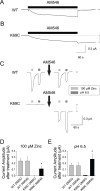
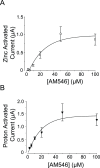
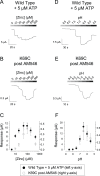
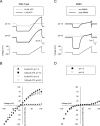

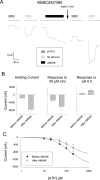
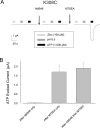


References
-
- Kanjhan R, Housley GD, Burton LD, Christie DL, Kippenberger A, et al. (1999) Distribution of the P2X2 receptor subunit of the ATP-gated ion channels in the rat central nervous system. J Comp Neurol 407: 11–32. - PubMed
-
- Cockayne DA, Hamilton SG, Zhu QM, Dunn PM, Zhong Y, et al. (2000) Urinary bladder hyporeflexia and reduced pain-related behaviour in P2X3-deficient mice. Nature 407: 1011–1015. - PubMed
-
- Finger TE, Danilova V, Barrows J, Bartel DL, Vigers AJ, et al. (2005) ATP signaling is crucial for communication from taste buds to gustatory nerves. Science 310: 1495–1499. - PubMed
Publication types
MeSH terms
Substances
Grants and funding
LinkOut - more resources
Full Text Sources
Other Literature Sources

